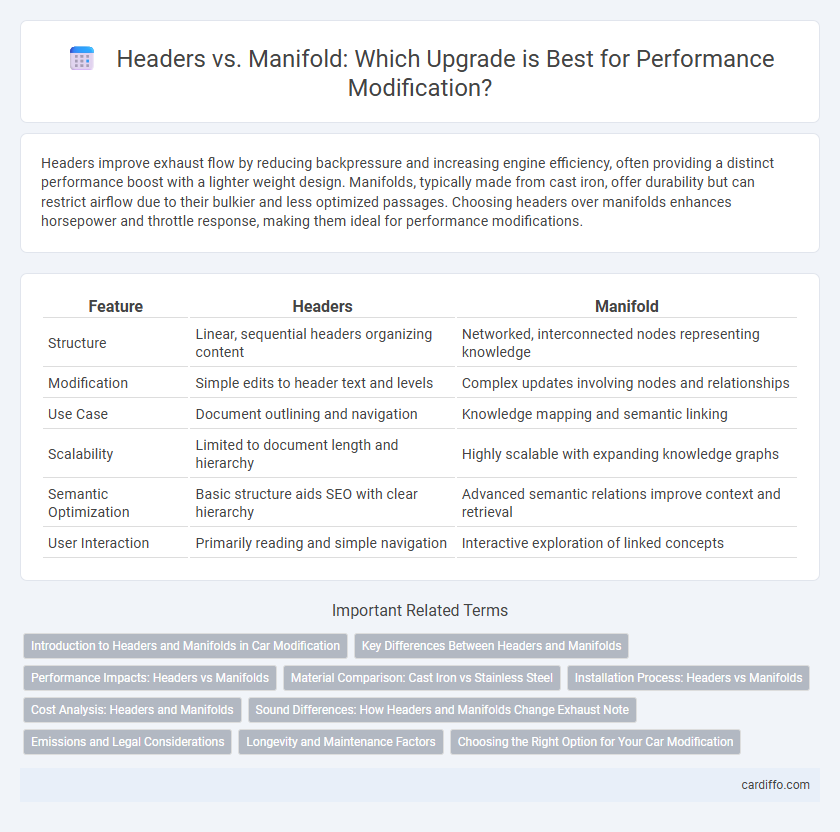Headers improve exhaust flow by reducing backpressure and increasing engine efficiency, often providing a distinct performance boost with a lighter weight design. Manifolds, typically made from cast iron, offer durability but can restrict airflow due to their bulkier and less optimized passages. Choosing headers over manifolds enhances horsepower and throttle response, making them ideal for performance modifications.
Table of Comparison
| Feature | Headers | Manifold |
|---|---|---|
| Structure | Linear, sequential headers organizing content | Networked, interconnected nodes representing knowledge |
| Modification | Simple edits to header text and levels | Complex updates involving nodes and relationships |
| Use Case | Document outlining and navigation | Knowledge mapping and semantic linking |
| Scalability | Limited to document length and hierarchy | Highly scalable with expanding knowledge graphs |
| Semantic Optimization | Basic structure aids SEO with clear hierarchy | Advanced semantic relations improve context and retrieval |
| User Interaction | Primarily reading and simple navigation | Interactive exploration of linked concepts |
Introduction to Headers and Manifolds in Car Modification
Headers and manifolds are essential components in car modification that influence engine performance and exhaust flow. Headers replace the standard exhaust manifold to improve exhaust gas evacuation by providing individual tubes for each cylinder, reducing backpressure and enhancing horsepower. Manifolds, typically made from cast iron, serve as the original exhaust collector but are less efficient than headers in optimizing engine output and throttle response.
Key Differences Between Headers and Manifolds
Headers and manifolds both distribute fluid or gas flow within engines or exhaust systems but differ significantly in design and function. Headers consist of individual tubes that optimize exhaust flow from each cylinder, reducing backpressure and improving performance, while manifolds typically use a single casting with a shared chamber that is simpler but less efficient. Headers offer superior exhaust scavenging and increased horsepower, whereas manifolds prioritize cost-effectiveness and durability.
Performance Impacts: Headers vs Manifolds
Headers improve engine performance by allowing each cylinder to expel exhaust gases independently, reducing backpressure and enhancing exhaust flow. In contrast, manifolds consolidate exhaust from multiple cylinders earlier, which can increase backpressure and limit exhaust scavenging, potentially decreasing overall horsepower and torque. Optimizing header design with tuned lengths and diameters maximizes volumetric efficiency, while manifolds offer simplicity but generally lower performance gains.
Material Comparison: Cast Iron vs Stainless Steel
Cast iron headers offer superior heat retention and durability but are prone to cracking under extreme thermal cycling, making them ideal for street applications focused on longevity. Stainless steel manifolds provide enhanced corrosion resistance and lightweight properties while maintaining high strength at elevated temperatures, preferred for performance-oriented and off-road modifications. Comparing materials, cast iron excels in cost-effectiveness and longevity under moderate stress, whereas stainless steel is favored for its resistance to rust and ability to withstand aggressive driving conditions.
Installation Process: Headers vs Manifolds
Headers require a more complex installation process due to their individual tubes that must be precisely aligned and secured to the engine block, often necessitating professional tools and expertise. In contrast, manifolds offer a simpler, bolt-on installation with fewer parts, making them more accessible for DIY mechanics. Proper gasket placement and torque specifications are critical in both to prevent leaks and ensure optimal engine performance.
Cost Analysis: Headers and Manifolds
Headers typically offer improved exhaust flow and engine performance but come at a higher initial cost compared to manifolds. Manifolds are generally more affordable and easier to install, making them a cost-effective choice for budget-conscious modifications. Evaluating long-term benefits and performance gains against upfront expenses is crucial for an optimal cost analysis between headers and manifolds.
Sound Differences: How Headers and Manifolds Change Exhaust Note
Headers typically produce a louder, more aggressive exhaust note due to their design that minimizes backpressure and allows gases to flow freely from each cylinder, enhancing engine sound intensity. In contrast, manifolds often create a deeper, more muted exhaust tone by merging exhaust pulses earlier, which smooths out sound waves and reduces overall noise levels. The distinct sound differences stem from headers' equal-length tubing promoting distinct exhaust pulses, while manifolds' collector design blends these pulses, altering the exhaust note character significantly.
Emissions and Legal Considerations
Headers typically enhance exhaust flow and increase engine performance but may result in higher emissions due to reduced backpressure control. Manifolds are generally designed to maintain emissions compliance by optimizing exhaust scavenging and ensuring proper catalytic converter function. Legal considerations require headers to meet specific emission standards and regulations, which vary by region, making manifold installations a preferred option for street-legal vehicles.
Longevity and Maintenance Factors
Headers typically offer improved exhaust flow and higher performance but may require more frequent maintenance due to their exposure to extreme heat and potential for cracking. Manifolds, being cast as a single piece, generally provide better durability and longevity, with less susceptibility to warping or leaks over time. Maintenance efforts for headers often include regular inspections and gaskets replacement, while manifolds tend to demand fewer repairs, making them a more reliable long-term choice in demanding conditions.
Choosing the Right Option for Your Car Modification
Headers improve exhaust flow and increase horsepower by replacing restrictive factory manifolds, offering better performance for high-revving engines. Manifolds are generally more affordable, provide better low-end torque, and fit more easily into tight engine bays, making them ideal for daily drivers and mild modifications. Choosing between headers and manifolds depends on your car's intended use, budget, and desired balance between power gains and drivability.
Headers vs Manifold Infographic

 cardiffo.com
cardiffo.com